
LEDA 83677 is a lenticular galaxy located about 290 million light-years away in the constellation Coma Berenices. It is a member of the Coma cluster of galaxies. LEDA 83677 is also classified as a type 1 Seyfert galaxy. The core of the galaxy is emitting high-energy X-rays and ultraviolet light, probably caused by a massive black hole lurking in the core.
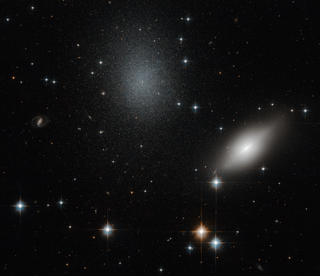
NGC 5011 is an elliptical galaxy in the constellation of Centaurus. It was discovered on 3 June 1834 by John Herschel. It was described as "pretty bright, considerably small, round, among 4 stars" by John Louis Emil Dreyer, the compiler of the New General Catalogue.

ESO 198-13 is a ring galaxy with multiple ring-like structures located about 240 million light-years away in the constellation Eridanus.
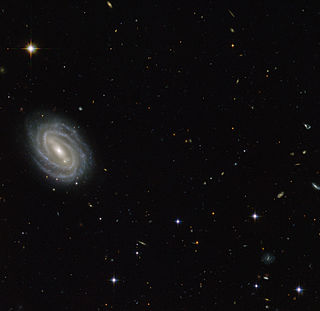
PGC 54493 is a barred spiral galaxy located about 490 million light-years away in the constellation Serpens. It is part of a galaxy group called Abell 2052. It has an estimated diameter of 140,000 light-years.

NGC 4488 is a lenticular galaxy located about 60 million light-years away in the constellation of Virgo. The galaxy was discovered by astronomer William Herschel on December 28, 1785. NGC 4488 is a member of the Virgo Cluster.

PGC 1 is a radio galaxy located about 1.1 billion light-years away in the constellation Pisces.

NGC 4612 is a barred lenticular galaxy located about 57 million light-years away in the constellation of Virgo. NGC 4612 was discovered by astronomer William Herschel on January 23, 1784. The galaxy is a member of the Virgo Cluster.

PGC 44691 is a spiral galaxy located about 350 million light-years away in the constellation Coma Berenices. It belongs to a galaxy cluster known as the Coma Cluster. In 1994, the Hubble Space Telescope observed PGC 44691 and the nearby elliptical galaxy NGC 4881 to infer the distance to the Coma Cluster.
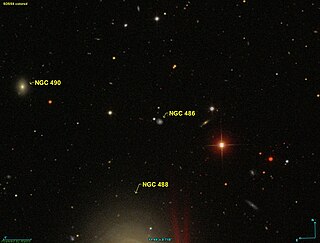
NGC 486, also occasionally referred to as LEDA 1281966 or GC 275, is a spiral galaxy in the constellation Pisces. NGC 486 was discovered on December 6, 1850 by Irish engineer Bindon Blood Stoney.

NGC 492, also occasionally referred to as PGC 4976 or GC 280, is a barred spiral galaxy in the constellation Pisces. It is located approximately 590 million light-years from Earth and was discovered on December 6, 1850 by Irish engineer Bindon Blood Stoney. Although John Dreyer, creator of the New General Catalogue, credits the discovery to astronomer William Parsons, 3rd Earl of Rosse, he notes that many of his claimed discoveries were made by one of his assistants. In the case of NGC 492, the discovery was made by Bindon Stoney, who discovered it along with NGC 486, NGC 490 and NGC 500 during his observation of NGC 488 using Lord Rosse's 72" telescope.
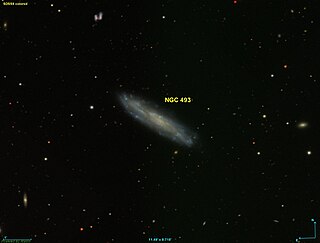
NGC 493, also occasionally referred to as PGC 4979 or GC 281, is a barred spiral galaxy in the constellation Cetus. It is located approximately 90 million light-years from Earth and was discovered on December 20, 1786 by astronomer William Herschel. It was later also observed by his son, John Herschel. John Dreyer, creator of the New General Catalogue, described the galaxy as "very faint, large, much extended 60°" with "a little brighter middle".

NGC 502, also occasionally referred to as PGC 5034 or UGC 922, is a lenticular galaxy in the constellation Pisces. It is located approximately 113 million light-years from the Solar System and was discovered on 25 September 1862 by German astronomer Heinrich Louis d'Arrest. When the Morphological Catalogue of Galaxies was published between 1962 and 1974, the identifications of NGC 502 and NGC 505 were reversed. In reality, NGC 502 is equal to MGC +01-04-041 and not MCG +01-04-043 as noted in the catalogue.

NGC 521, also occasionally referred to as PGC 5190 or UGC 962, is a spiral galaxy located approximately 224 million light-years from the Solar System in the constellation Cetus. It was discovered on 8 October 1785 by astronomer William Herschel.

NGC 527, also occasionally referred to as PGC 5128 or PGC 5141, is a lenticular galaxy located approximately 259 million light-years from the Solar System in the constellation Sculptor. It was discovered on 1 September 1834 by astronomer John Herschel.

NGC 1264 is a low-surface-brightness barred spiral galaxy located about 145 million light-years away in the constellation Perseus. The galaxy was discovered by astronomer Guillaume Bigourdan on October 19, 1884. NGC 1264 is a member of the Perseus Cluster.
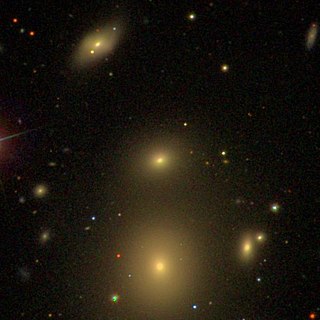
NGC 3841 is an elliptical or lenticular galaxy located about 300 million light-years away in the constellation Leo. It was discovered by astronomer John Herschel on March 25, 1827 is a member of the Leo Cluster.

NGC 3861 is a large barred spiral galaxy with a ring-like structure located about 310 million light-years away in the constellation Leo. It was discovered by astronomer John Herschel on March 23, 1827. NGC 3861 is a member of the Leo Cluster and has a normal amount of neutral hydrogen and ionised hydrogen.
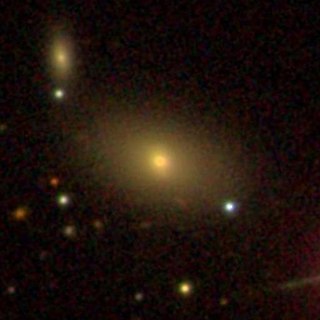
NGC 6054 is a barred lenticular galaxy located about 460 million light-years away in the constellation Hercules. It was discovered by astronomer Lewis Swift on June 27, 1886. It was then rediscovered by astronomer Guillaume Bigourdan on June 1, 1888. PGC 57073 is often misidentified as NGC 6054. NGC 6054 is a member of the Hercules Cluster.

NGC 688 is a barred spiral galaxy with starburst activity located 190 million light-years away in the constellation Triangulum. It was discovered by astronomer Heinrich d'Arrest on September 16, 1865 and is a member of the galaxy cluster Abell 262.
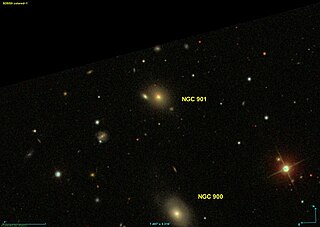
NGC 901 is an elliptical galaxy in the constellation Aries. It is estimated to be 441 million light years from the Milky Way and has a diameter of approximately 50,000 ly. NGC 901 was discovered on September 5, 1864, by Albert Marth.




















